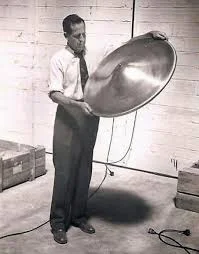Beifeld-Brown Effect – At a Glance
The Biefeld-Brown Effect, once relegated to fringe science, is gaining renewed attention as researchers explore the potential to influence gravity with electricity. Originating from Townsend Brown’s early experiments with Dr. Paul Biefeld, the effect involves measurable motion from asymmetric capacitors under high-voltage conditions. Brown’s careful testing, including in vacuum chambers, challenged mainstream physics. Today, modern validations and growing interest in clean energy and advanced propulsion have pushed this effect back into the spotlight. If scalable, the Biefeld-Brown Effect could revolutionize transportation, space travel, and our understanding of the fundamental forces that shape the universe.
Read time: 6 minutes
Introduction
If gravity can be influenced electrically, the future of propulsion could shift dramatically. The Biefeld-Brown Effect, often relegated to fringe science, is resurfacing as researchers question the limits of conventional physics. Townsend Brown’s meticulous tests and modern validations are creating new momentum around this old idea. With clean energy and space propulsion top of mind, it may be time to reexamine what was once dismissed.
Historical Foundations of the Biefeld-Brown Effect

Townsend Brown worked closely with Dr. Paul Biefeld in the early 20th century, investigating how electricity could affect mass. Brown was meticulous, ensuring no interference from outside forces. In one experiment, he submerged asymmetric capacitors in mineral oil to prevent air contamination. He then applied 300,000 volts, resulting in measurable movement.
In another test, Brown mounted two 44-pound metal conducting spheres on a 12-foot rod suspended by a support. When subjected to 400,000 volts, the assembly moved. These findings were not isolated incidents. Brown documented them in British Patent No. 300,311, introducing the term electrogravitics and laying the groundwork for what is now known as the Biefeld-Brown Effect—a phenomenon that has sparked curiosity and controversy for decades.
Beyond the Patent: Rhythms of the Moon and Sun
Brown’s observations extended beyond laboratory settings. Over time, he noticed fluctuations in his devices’ behavior in relation to the Moon’s 28-day cycle and the Earth’s seasonal movement around the Sun. He theorized that gravitational fields might influence or even interact with the electric fields produced by his asymmetric capacitors.
This hypothesis, suggesting a link between gravity, magnetism, and electricity, challenged established science. Many physicists of the time dismissed his work, attributing the movement to ion wind, the idea that charged particles create thrust as they move through air. Yet for those studying the Biefeld-Brown Effect, these environmental influences raised deeper questions about the nature of the forces at play.
Theoretical Integrity: Testing the Biefeld-Brown Effect in a Vacuum
Brown wasn’t convinced by the ion wind explanation, and neither were others. To eliminate air as a variable, he repeated his experiments in vacuum chambers. The movement persisted.
Independent researchers, including Jean Louis Naudin, Russell Anderson, and I, have replicated many of Brown’s tests. Most recently, Mark Sokol, of Falcon Space, demonstrated a working device in a vacuum on the APEC (Alternative Propulsion Engineering Conference) platform. These confirmations reignite interest in the real potential behind Brown’s original discoveries and continue to validate the Biefeld-Brown Effect as more than just theoretical speculation.
Implications for Propulsion and Beyond
If these findings hold up to further scrutiny, they could fundamentally alter how we think about propulsion. The idea of harnessing high voltage fields to create motion without combustion, noise, or emissions opens up new possibilities in aerospace, clean transportation, and deep space travel.
It also brings renewed interest to long-dismissed theories that suggest gravity might be manipulated through electromagnetic forces. The Biefeld-Brown Effect stands at the center of this shift. What was once considered fringe may now be on the edge of a scientific breakthrough.
What This Could Mean: New Roads in Propulsion
If high-voltage capacitive setups can create thrust without combustion or moving parts, the implications are vast. From silent aerospace vehicles to field-based terrestrial propulsion, we may be looking at the building blocks for cleaner, more efficient transportation systems.
More provocatively, if Brown’s speculation about gravitational interactions holds, this could open the door to a unified theory of forces—one that science has been chasing for over a century. The Biefeld-Brown Effect may be more than an experimental curiosity; it could be a key that unlocks the next era of discovery.
“Clean energy is not a burden; it’s an opportunity—an opportunity to reshape our world.”
— Christiana Figueres
What We Know So Far about the Beifeld-Brown Effect
Townsend Brown’s research, once dismissed, now stands as a compelling invitation to reconsider the limits of what’s possible. As experiments continue to confirm motion without combustion or moving parts, the Biefeld-Brown Effect may offer a glimpse into propulsion’s next frontier. It also suggests something more, a potential link between electricity and gravity that could reshape modern physics. If such a connection truly exists, it would challenge long-held scientific assumptions and open pathways to discoveries we’ve only imagined.
Which variable in the Biefeld-Brown setup do you think holds the most untapped potential for discovery?
Ready to Bring This Conversation to the Room?
These ideas tend to surface quietly, among engineers in after-hours experiments or researchers following threads outside the mainstream. But more and more, they’re becoming part of larger conversations in science forums, universities, and innovation events.
If your group, team, or audience is exploring propulsion, field-based systems, or the outer edge of physics, I offer presentations and keynotes that bring historical context, modern replication, and future implications into clear, grounded focus.
📩 Reach out at 👉 letstalk@larrydeavenport.com or schedule a time to talk about bringing this work into your next event, gathering, or conference.
Sometimes, all it takes to unlock a new direction is hearing the right story at the right moment.
About the Author

Larry Deavenport is a researcher, speaker, and educator with more than 40 years of experience exploring the frontier of electrokinetics, which he calls energy in motion. As founder of Deavenport Technology, he is dedicated to equipping innovators, researchers, and engineers with the clarity, tools, and mentorship they need to transform scattered theories into working prototypes.
Larry’s work focuses on bridging the gap between curiosity-driven experimentation and practical application. His teaching combines structured principles, hands-on demonstrations, and one-on-one guidance to help learners refine breakthroughs and accelerate discoveries. Through his keynotes, workshops, mentoring programs, and his two signature master courses, Larry inspires a new generation of pioneers to explore advanced gravitics and motion-based energy systems that align with natural forces and reduce environmental impact.
Passionate about both discovery and education, Larry continues to share his research and insights at conferences, in collaborative forums, and through his growing platform at Deavenport Technology. His mission is to guide bold thinkers who are ready to move from possibility into progress, shaping the future of sustainable energy and redefining what is possible.
References
- British Patent No. 300,311 (1928) – Method of and Apparatus for Producing Force or Motion by Thomas Townsend Brown, Available via Espacenet Patent Database
- Electrogravitics Systems: Reports on a New Propulsion Methodology by Thomas Valone, PhD (2004), Published by Integrity Research Institute, https://www.integrityresearchinstitute.org
- Breakthrough Propulsion Physics Program – Marc Millis, NASA Glenn Research Center, Available through the NASA Technical Reports Server, https://ntrs.nasa.gov
- APEC (Alternative Propulsion Engineering Conference) – Presentations by Mark Sokol, Falcon Space, Includes documented vacuum tests on field-based propulsion, https://www.altpropulsion.com
- Lifter and Vacuum Test Results by Jean-Louis Naudin, Independent replications of the Biefeld-Brown Effect, http://jnaudin.free.fr
- Secrets of Antigravity Propulsion by Paul A. LaViolette, PhD (2008), Published by Bear & Company
- Dr. Paul Biefeld Papers, Denison University Special Collections, Archival materials on early, experiments and correspondence, https://denison.edu



